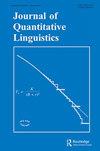波斯语衍生词尾生产力:一个模糊分析
IF 1.7
2区 文学
0 LANGUAGE & LINGUISTICS
引用次数: 0
摘要
本文的主要目的是介绍一种处理波斯语中后缀生产力模糊概念的新方法。这种方法,即模糊集合理论,赋予每个后缀从[0,1]到不同生产力类别的隶属度。为了评估波斯语后缀的形态生产力,首先将Baayen提出的已实现生产力、扩展生产力和潜在生产力指标应用于Bijankhan语料。相应的,使用MATLAB和Microsoft Excel软件对语料库中的260万个单词进行调查分析。在接下来的步骤中,三个生产率度量的结果分别用模糊图来说明。研究结果表明,所采用的三种措施可以更广泛地了解波斯语派生后缀生产力的不同方面。利用模糊集理论可以使一个给定后缀同时属于不同隶属度的不同类别。根据本研究的统计,到目前为止,在最多产的后缀中,- i和- e在波斯语中的隶属度最高。同样,他们继续对当代波斯语词汇的增长率做出最大贡献。本文章由计算机程序翻译,如有差异,请以英文原文为准。
Derivational Suffix Productivity in Persian: A Fuzzy Analysis
ABSTRACT The main aim of this article is to introduce a new way of dealing with the vague concept of suffix productivity in Persian. This approach, that is fuzzy set theory, gives each suffix a degree of membership from [0,1] to different productivity categories. To estimate morphological productivity of Persian suffixes, first Baayen’s proposed measures, i.e. realized productivity, expanding productivity and potential productivity were applied to Bijankhan corpus. Correspondingly, 2.6 million words in the corpus were investigated and analysed using MATLAB and Microsoft Excel software. In the next step, the results of the three productivity measures were illustrated on separate fuzzy diagrams. The findings showed that the three measures employed could give a broader view of different aspects of derivational suffix productivity in Persian. Using fuzzy set theory makes it possible for a given suffix to belong simultaneously to different categories with different degrees of membership. According to the statistics of this research, suffixes – i and – e in Persian had the highest degrees of membership among the most productive suffixes up to now. Likewise, they continue to contribute the most to the growth rate of the contemporary Persian lexicon.
求助全文
通过发布文献求助,成功后即可免费获取论文全文。
去求助
来源期刊

Journal of Quantitative Linguistics
Multiple-
CiteScore
2.90
自引率
7.10%
发文量
7
期刊介绍:
The Journal of Quantitative Linguistics is an international forum for the publication and discussion of research on the quantitative characteristics of language and text in an exact mathematical form. This approach, which is of growing interest, opens up important and exciting theoretical perspectives, as well as solutions for a wide range of practical problems such as machine learning or statistical parsing, by introducing into linguistics the methods and models of advanced scientific disciplines such as the natural sciences, economics, and psychology.
 求助内容:
求助内容: 应助结果提醒方式:
应助结果提醒方式:


